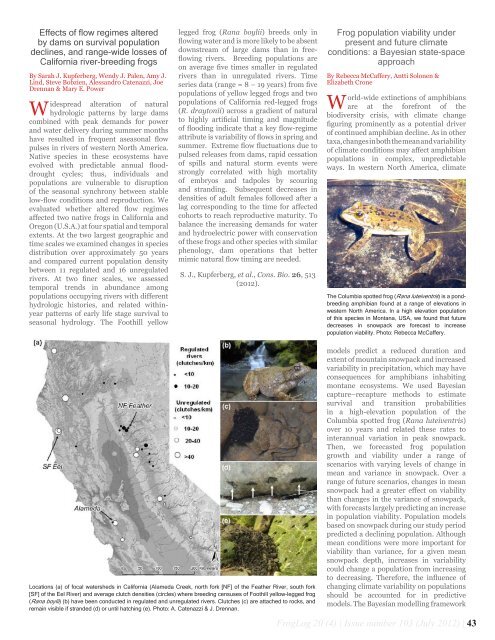FrogLog 103 PDF here - Amphibian Specialist Group
FrogLog 103 PDF here - Amphibian Specialist Group
FrogLog 103 PDF here - Amphibian Specialist Group
Create successful ePaper yourself
Turn your PDF publications into a flip-book with our unique Google optimized e-Paper software.
Effects of flow regimes altered<br />
by dams on survival population<br />
declines, and range-wide losses of<br />
California river-breeding frogs<br />
By Sarah J. Kupferberg, Wendy J. Palen, Amy J.<br />
Lind, Steve Bobzien, Alessandro Catenazzi, Joe<br />
Drennan & Mary E. Power<br />
Widespread alteration of natural<br />
hydrologic patterns by large dams<br />
combined with peak demands for power<br />
and water delivery during summer months<br />
have resulted in frequent aseasonal flow<br />
pulses in rivers of western North America.<br />
Native species in these ecosystems have<br />
evolved with predictable annual flooddrought<br />
cycles; thus, individuals and<br />
populations are vulnerable to disruption<br />
of the seasonal synchrony between stable<br />
low-flow conditions and reproduction. We<br />
evaluated whether altered flow regimes<br />
affected two native frogs in California and<br />
Oregon (U.S.A.) at four spatial and temporal<br />
extents. At the two largest geographic and<br />
time scales we examined changes in species<br />
distribution over approximately 50 years<br />
and compared current population density<br />
between 11 regulated and 16 unregulated<br />
rivers. At two finer scales, we assessed<br />
temporal trends in abundance among<br />
populations occupying rivers with different<br />
hydrologic histories, and related withinyear<br />
patterns of early life stage survival to<br />
seasonal hydrology. The Foothill yellow<br />
legged frog (Rana boylii) breeds only in<br />
flowing water and is more likely to be absent<br />
downstream of large dams than in freeflowing<br />
rivers. Breeding populations are<br />
on average five times smaller in regulated<br />
rivers than in unregulated rivers. Time<br />
series data (range = 8 − 19 years) from five<br />
populations of yellow legged frogs and two<br />
populations of California red-legged frogs<br />
(R. draytonii) across a gradient of natural<br />
to highly artificial timing and magnitude<br />
of flooding indicate that a key flow-regime<br />
attribute is variability of flows in spring and<br />
summer. Extreme flow fluctuations due to<br />
pulsed releases from dams, rapid cessation<br />
of spills and natural storm events were<br />
strongly correlated with high mortality<br />
of embryos and tadpoles by scouring<br />
and stranding. Subsequent decreases in<br />
densities of adult females followed after a<br />
lag corresponding to the time for affected<br />
cohorts to reach reproductive maturity. To<br />
balance the increasing demands for water<br />
and hydroelectric power with conservation<br />
of these frogs and other species with similar<br />
phenology, dam operations that better<br />
mimic natural flow timing are needed.<br />
S. J., Kupferberg, et al., Cons. Bio. 26, 513<br />
(2012).<br />
Frog population viability under<br />
present and future climate<br />
conditions: a Bayesian state-space<br />
approach<br />
By Rebecca McCaffery, Antti Solonen &<br />
Elizabeth Crone<br />
World-wide extinctions of amphibians<br />
are at the forefront of the<br />
biodiversity crisis, with climate change<br />
figuring prominently as a potential driver<br />
of continued amphibian decline. As in other<br />
taxa, changes in both the mean and variability<br />
of climate conditions may affect amphibian<br />
populations in complex, unpredictable<br />
ways. In western North America, climate<br />
The Columbia spotted frog (Rana luteiventris) is a pondbreeding<br />
amphibian found at a range of elevations in<br />
western North America. In a high elevation population<br />
of this species in Montana, USA, we found that future<br />
decreases in snowpack are forecast to increase<br />
population viability. Photo: Rebecca McCaffery.<br />
Locations (a) of focal watersheds in California (Alameda Creek, north fork [NF] of the Feather River, south fork<br />
[SF] of the Eel River) and average clutch densities (circles) w<strong>here</strong> breeding censuses of Foothill yellow-legged frog<br />
(Rana boylii) (b) have been conducted in regulated and unregulated rivers. Clutches (c) are attached to rocks, and<br />
remain visible if stranded (d) or until hatching (e). Photo: A. Catenazzi & J. Drennan.<br />
models predict a reduced duration and<br />
extent of mountain snowpack and increased<br />
variability in precipitation, which may have<br />
consequences for amphibians inhabiting<br />
montane ecosystems. We used Bayesian<br />
capture–recapture methods to estimate<br />
survival and transition probabilities<br />
in a high-elevation population of the<br />
Columbia spotted frog (Rana luteiventris)<br />
over 10 years and related these rates to<br />
interannual variation in peak snowpack.<br />
Then, we forecasted frog population<br />
growth and viability under a range of<br />
scenarios with varying levels of change in<br />
mean and variance in snowpack. Over a<br />
range of future scenarios, changes in mean<br />
snowpack had a greater effect on viability<br />
than changes in the variance of snowpack,<br />
with forecasts largely predicting an increase<br />
in population viability. Population models<br />
based on snowpack during our study period<br />
predicted a declining population. Although<br />
mean conditions were more important for<br />
viability than variance, for a given mean<br />
snowpack depth, increases in variability<br />
could change a population from increasing<br />
to decreasing. T<strong>here</strong>fore, the influence of<br />
changing climate variability on populations<br />
should be accounted for in predictive<br />
models. The Bayesian modelling framework<br />
<strong>FrogLog</strong> 20 (4) | Issue number <strong>103</strong> (July 2012) | 43
















